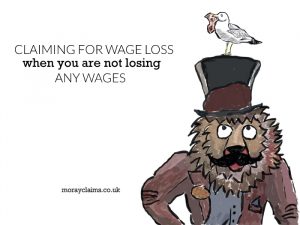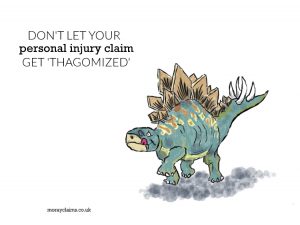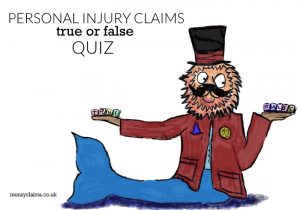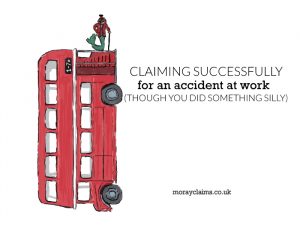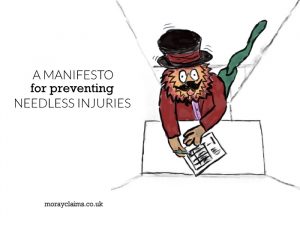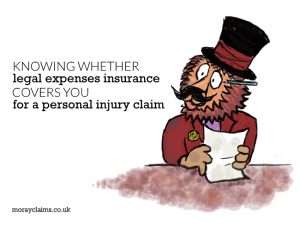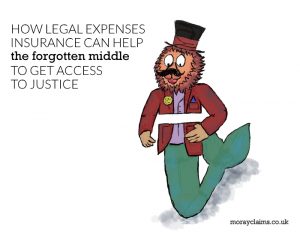You don’t usually get something for nothing. We’ve talked about that issue before when answering the question: How does your personal injury solicitor make money if they do not charge you anything? In the context of a personal injury compensation claim, claiming for wage loss when you are not losing any wages sounds like getting something for nothing – getting a windfall - but it’s not like that at all. To understand how you might claim for future wage loss when you’re not currently losing any wages, we need to consider 3 things, which we’ll do in the remainder of this article. Firstly, how is wage loss normally calculated? Secondly, in what circumstances, might you be able to claim wage loss when you’re not losing any wages? And, finally, how is the calculation made? Let’s look at wage loss claims generally, for a start. If you have a personal injury claim, wage loss may be an important part of your claim. It may be the main reason you decided to make a claim at Continue Reading
What PPE duties do employers have?
How bad for you is 37 grammes of saturated fat? According to recommendations from the US Department of Agriculture (USDA) in 1992, a normal diet should contain no more than 20 grammes of saturated fat per day. Do you have any idea what 37 grammes of saturated fat looks like? USDA research found that a typical medium-sized bag of film theatre popcorn contained that much saturated fat. But unless you’re a nutritionist, the bare quantity '37g' might not be too great in convincing you of the riskiness of your movie-time snack. Instead, USDA got their message across by highlighting the other foods which taken together would contain the same dosage of artery-clogging fat as the apparently innocent between-meals filler - A Big Mac with chips, plusA bacon and eggs breakfast, plusA steak supper with all the trimmings, equals37g of saturated fat. The scientific analysis of the popcorn amounted to a risk assessment. USDA needed to get the hazardous results across to the Continue Reading
Don’t let your personal injury claim get thagomized (by getting a move on now)
Do you know what a thagomizer is? The thagomizer is an arrangement of 4 to 10 spikes on the tails of dinosaurs such as the Stegosaurus. The pointy bits provided a defensive weapon against predators. Stegosaurus was a herbivore. With a toothless beak and small teeth, it was not designed to eat flesh. Legendary cartoonist, Gary Larson, coined the term ‘thagomizer’ in his 1982 image of a caveman giving a PowerPoint presentation to colleagues and telling them it was so-called “after the late Thag Simmons”. Poor Thag. ‘Thagomizer’ has come to be adopted as an informal anatomical term. It’s used on the Stegosaurus display at the Smithsonian Institute in Washington D.C.. Clearly, Stegosaurus had a mighty sting in the tail, if required. Personal injury claims can have a sting in the tail too, if you don’t watch out. The cruel defence is one of ‘delay’. Wait too long and your claim will become unenforceable and lost forever. As we have discussed elsewhere, the Continue Reading
Personal Injury Claims True or False Quiz
Here are 12 questions about personal injury claims in Scotland. There are some local, Moray elements thrown in too. This covers things like: At the end, we'll tell you your score and the answers. Should have any questions at all, please get in touch with us. All enquiries are free of charge and without obligation. See the article HERE, if you want to understand more about what will actually happen if you get in touch with us about making a personal injury compensation claim in Moray. Continue Reading
Restarting Personal Injury Claims in the Sheriff Court
Personal injury claims in the Sheriff Court are more or less at a standstill. Though the lockdown was quite sudden when it came, in some ways, it had been predicted. Scottish Courts and Tribunal Service (SCTS) had been making positive noises about how it might be possible to keep the litigation process going by means of telephone conferencing or written submissions. However, the guidance issued for Sheriff Courts on 25 March 2020 indicated that only essential court business would proceed. For most types of civil court business – including personal injury and family law cases – the litigation process was frozen. Civil court hearings for personal injury actions scheduled for final hearings with witnesses between March and June 2020 were postponed. This applies across all Sheriff Courts, including our own local Elgin Sheriff Court. There has been criticism of the apparent slowness of the courts to adapt. Here's a report from the website of the Law Society of Continue Reading
Claiming successfully for an accident at work though you did something silly
Have you ever panicked that you have mislaid your mobile phone? And that while you are in the middle of a conversation with someone on your mobile phone? This happens to me regularly. So many things compete for our attention and so much of the activity that fills our day is done almost unconsciously, on autopilot. The repetitiveness of everyday life dulls our concentration and our short-term memories. Sometimes distractions can be a source of danger, whether that’s while you’re descending the stairs in your house or crossing the street or working on a production line. In this article we are going to concentrate on accidents at work. We will look at 3 different accident scenarios where you might think the injured employee 'should have known better' yet still claimed successfully. Firstly, we’ll look at the case of the exposed window cleaner. Then, we’ll go on to consider the case of the labourer with inappropriate footwear. Finally, we’ll go over the case of the bus Continue Reading
Prevention of needless injuries (the APIL manifesto)
How many accidents are there in the UK each year which cause injury to people? One estimate is 1.6 million – totalling up harmful incidents across workplaces, hospitals and on the roads. (There were 560,000 casualties on the roads in 2018). All of these are preventable injuries. Yet they can have permanent, life-changing consequences not just for the injury victims but also for their families. On the other side of the picture, the wrongdoer who caused the injuries – an employer, the NHS, a business, a local authority – can suffer damage to reputation as well as financial cost. Every year, the Association of Personal Injury Lawyers (APIL) hosts Injury Prevention Day. It encourages us all to think about ways we can adjust our conduct to minimise the risk of harm to others (e.g. avoiding tailgating the vehicle in front if we are driving). Everyone has a part to play in reducing accidental injuries but, for maximum effectiveness, the lead has to come from government. It is our Continue Reading
Knowing whether Legal Expenses Insurance covers you for a personal injury claim
We thought it might be helpful to analyse a clause from a legal expenses insurance (LEI) policy relating to cover for making a personal injury claim. It’s just one type of clause out of many in a LEI policy but it is a foundational one relative to personal injury claims. What is LEI? LEI is one way to insure yourself against the risk that a personal injury compensation claim you make might fail in such a way that you could be responsible for the costs (legal expenses) of your opponent. Typically, that can only happen if you get to the stage where you have to raise a court action to pursue your claim – so legal expenses insurance is insuring you against the risk of losing your claim in court. While it is possible to buy LEI as a standalone policy, most LEI policies are added to home or car insurance as an optional extra. LEI policies bought ‘before the event’ (BTE) protect policyholders in case legal action has to be brought or defended in the future. This type of policy would be Continue Reading
How to avoid throwing money away on your personal injury claim
Scottish solicitors’ firms have to do formal risk management training every year. This is particularly to minimise the risk of making mistakes which might mean we end up getting sued because of losses we might cause to our clients. We had a recent session in our Elgin office where the “system” to assess risks in our work on a daily basis was summarised as: Stop and think Do as you have been told (i.e. we have a lot of systems and procedures already for managing risk) Repeat one and two Everything looks clear with hindsight. You want to avoid looking back on things with regret, if possible. It can be especially annoying if, due to not “stopping and thinking”, you make a silly error which results in a loss to you personally or to your workplace. It’s a bit like that with personal injury claims and, from our perspective, there is an avoidable mistake many injured people make at the start of their personal injury claim. It causes financial loss to them. It’s not obvious, though, Continue Reading
If you travel with a drunk driver and get injured
If you travel with a drunk driver and get injured due to their bad driving, does that mean you can’t claim? A September 2019 poll commissioned by Glasgow-based solicitors, Dallas MacMillan, indicated that two-thirds of those polled believed that if you agree to be a passenger in a car driven by someone you know is under the influence of alcohol, you won’t be able to claim compensation from the driver if they crash the car and you’re injured. This 66% (or so) majority are mistaken in their understanding of the law. People injured in such circumstances can claim successfully – and you may be surprised by how fully they can claim. We agree that travelling with a driver who is under the influence is a very bad idea. On the other hand, you should not lose sight of the fact that passengers in vehicles very rarely have no compensation claim available to them if they are injured in an accident. In this article, we’ll look at the law on accidents involving passengers in vehicles driven Continue Reading
Is Legal Expenses Insurance worth it?
Legal expenses insurance (LEI) is also known as legal protection insurance or even just legal insurance. It can pay for the cost of legal advice, if you need help, in a variety of scenarios - for example - a boundary dispute with a neighbouring property owner a building dispute with a tradesman who has done work on your house an employment dispute a personal injury compensation claim following an accident The insurance can cover you whether you are the person initiating the claim or the person against whom the claim is being made. The main benefit of LEI is that it provides you with a route to justice which may otherwise be too expensive for you to consider. It can be a stand-alone policy but is often an add-on to other insurance, such as house contents insurance. Types of LEI There’s an important distinction between ‘before the event’ (BTE) LEI and ‘after the event’ (ATE) LEI. The ‘event’ is the thing that's happened for which you need the legal advice Continue Reading
How legal expenses insurance can give you access to justice (that might otherwise be denied)
I was renewing my first aid qualification recently and some statistics really hit home. Less than 1 in 10 people in Britain survive an out-of-hospital cardiac arrest. In countries where cardiopulmonary resuscitation (CPR) is taught in schools on the other hand (e.g. Norway), as many as 1 in 4 survive. It seems that providing folks with an early education in first aid fundamentals improves heart attack victims’ chances of making it through their experience alive. In the same way, a recent report by a group of international lawyers has argued that making Legal Expenses Insurance (LEI) more widely available would improve access to justice, giving some people a possible legal remedy where otherwise their chances would be as good as dead. In this article, we are going to consider 3 questions related to LEI. Firstly, what is LEI and what types of LEI exist? Secondly, who is most likely to benefit from taking out LEI? And, lastly, why you should make a general check of Continue Reading
